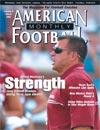AMERICAN FOOTBALL MONTHLY THE #1 RESOURCE FOR FOOTBALL COACHES
Article CategoriesAFM Magazine
|
Strong, Fast, AgileOklahoma\'s Jerry Schmidt has a firm grip on his athletes\' progress both off and on the football field.© More from this issue The job of the strength coach is not a complicated one. It is to build stronger players and to do it with efficiency and organization. If you help develop stronger players, your program has a better chance of playing winning football. And it's not just about building stronger players – it's about developing faster and quicker players. Give strong, fast and agile players to a head coach who is worth his salt and he will likely win a lot more games than he loses. Jerry Schmidt is the director of sports enhancement for the Oklahoma Sooners. No strength and conditioning coach has done more for his school than Schmidt....The full article can only be seen by subscribers. Subscribe today!
|
|
|||||||
| HOME |
MAGAZINE |
SUBSCRIBE | ONLINE COLUMNISTS | COACHING VIDEOS |
Copyright 2025, AmericanFootballMonthly.com
All Rights Reserved





